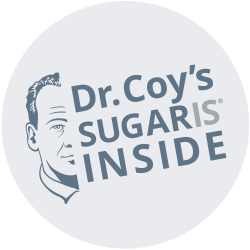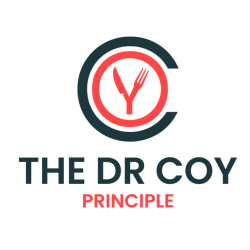Learn more about Dr. Coy and the creation of his sugar solutions.
Dr Johannes Coy is a world-renowned scientist whose research focuses on the health benefits of sugar awareness. Dr Coy has made a number of important genetic discoveries which change our understanding of cancer and nutrition and make him the leading expert on sugars.

Book: Fit with Sugar, by Dr Johannes Coy
Dr Coy has written several books about cancer nutrition. His latest book, Fit with Sugar, is now available. In this book, you’ll discover the evolutionary role of sugar in the human body. Consuming too much conventional sugar isn’t good for our health, but with the right sugars, we can stop cell ageing, keep the brain fit, protect against diseases and switch on fat burning. Find out how you can maintain physical and mental performance using natural low- glycaemic sugars and sugar substitutes. The book includes many delicious recipes for cakes, snacks and desserts, so you can implement a sugar-conscious diet easily and intelligently, without giving up sweet treats.
Buy the book: Cancer-Fighting Diet: Diet and Nutrition Strategies to Help Weaken Cancer Cells and Improve Treatment, by Dr Johannes Coy.
Research & Resources
Intracellular Protective Functions and Therapeutical Potential of Trehalose
Trehalose, a naturally occurring saccharide, is a multifunctional molecule that protects cells from various stress factors. It serves as an osmoprotectant, chemical chaperone, free radical scavenger, carbon source, and metabolic regulator, while also contributing to the virulence of bacteria and fungi. Research highlights its potential medical and therapeutic applications, emphasising its role in maintaining cellular homeostasis under stress.
Trehalose inhibits solute carrier 2A (SLC2A) proteins to induce autophagy and prevent hepatic steatosis
The accumulation of lipids in hepatocytes that occurs in nonalcoholic fatty liver disease (NAFLD) can result in liver failure or liver cancer. Trehalose is a ubiquitous sugar that is present in the food consumed by animals. DeBosch et al. determined that trehalose blocked glucose uptake into cells by inhibiting glucose transporters in the plasma membrane, which induced a “starvation”-like response that activated autophagy even in the presence of adequate nutrients and glucose. Furthermore, providing trehalose to mice that are a model of NAFLD prevented lipid accumulation in the liver. As noted by Mardones et al. in the associated Focus, trehalose, which has been previously under investigation to treat neurodegenerative diseases characterized by toxic protein aggregates, may be a “silver bullet” for treating diseases resulting from inadequate cellular degradative metabolism.
Association between HbA1c and carotid atherosclerosis among elderly Koreans with normal fasting glucose
This study investigated the association between glycated hemoglobin (HbA1c) and carotid atherosclerosis in an elderly Korean population with normal fasting glucose. The analysis of 1,133 participants revealed that higher HbA1c levels were independently associated with increased carotid intima-media thickness (IMT), indicating carotid atherosclerosis. This association remained significant after adjusting for various factors. However, fasting insulin and glucose levels did not show a significant association with carotid IMT. These findings suggest that HbA1c may serve as an informative marker for carotid atherosclerosis in elderly individuals with normoglycemia.
Advanced Glycation End Products: Building on the Concept of the “Common Soil” in Metabolic Disease
AGEs play a role in metabolic disorders like obesity and diabetes. They are formed when sugars bind to proteins or fats in our body. AGEs contribute to the development of these disorders by causing insulin resistance and inflammation. They can be produced inside our bodies or come from external sources like pollution, smoking, and unhealthy diets. The accumulation of AGEs in key organs disrupts metabolism and worsens the condition.
Metabolic reprogramming in chondrocytes to promote mitochondrial respiration reduces downstream features of osteoarthritis
This study looked at how changing the way chondrocytes (cartilage cells) get energy could help reduce damage linked to osteoarthritis. Normally, these cells rely heavily on a process called glycolysis, but by replacing glucose with galactose, the researchers forced the cells to depend more on their mitochondria for energy. This change improved mitochondrial function, reduced harmful byproducts like reactive oxygen species and nitric oxide, and decreased levels of MMP13, a molecule that breaks down cartilage. Overall, this suggests that targeting cell metabolism could be a new way to treat osteoarthritis.
Advanced Glycation End Products and Risks for Chronic Diseases: Intervening Through Lifestyle Modification
AGEs are compounds formed when sugars react with proteins, lipids, or nucleic acids in our bodies. They bind to receptors found on different cells and trigger various biological responses. This review summarizes the characteristics of AGEs, how they are measured, their receptors, and how their expression changes in different physiological and disease conditions. The review suggests lifestyle modifications to regulate the AGE-RAGE cycle for improved health.
Advanced Glycation End Products: New Clinical and Molecular Perspectives
AGEs are compounds formed when sugars react with proteins, lipids, or nucleic acids in our bodies. They bind to receptors found on different cells and trigger various biological responses. This review provides an overview of AGEs, including how they are measured and their interactions with receptors. It also discusses how AGE expression changes in different physiological and disease states. Lastly, the review suggests lifestyle choices that can help modulate the AGE-RAGE cycle for better health.
The role of advanced glycation end products in aging and metabolic diseases: bridging association and causality
Accumulation of advanced glycation end products (AGEs) on nucleotides, lipids, and proteins is a natural part of the aging process in all living organisms, including humans. Numerous studies have demonstrated that AGEs and their impaired forms play a role in aging-related changes and the development of age-related diseases. However, there is still much to uncover about how AGEs are formed, their causal relationship with these conditions, and whether interventions can be developed to prevent or reduce AGE-related damage. Invertebrate models such as Drosophila melanogaster and Caenorhabditis elegans can be valuable tools to explore AGE-related pathways and identify potential drugs that can mitigate the harmful effects of AGE accumulation. These models offer insights for further research and intervention development in this area.
Accumulation of advanced glycation end products (AGEs) during aging is associated with age-related changes and diseases. Invertebrate models like Drosophila melanogaster and Caenorhabditis elegans can help study AGE-related pathways and identify potential interventions to mitigate AGE-related damage.
Development and Progression of Non-Alcoholic Fatty Liver Disease: The Role of Advanced Glycation End Products
Non-alcoholic fatty liver disease (NAFLD) affects a significant portion of the adult population and is a leading cause of liver-related illness and mortality worldwide. Treatment mainly relies on lifestyle changes, which can be challenging for most patients. The progression from simple fatty liver to more severe forms, such as non-alcoholic steatohepatitis (NASH) and liver fibrosis, is explained by a “two-hit hypothesis.” Advanced glycation end products (AGEs), formed when sugars react with proteins or lipids, have emerged as major contributors to this second hit, driving the progression from steatosis to NASH through the receptor for AGEs (RAGE). Both endogenous and exogenous AGEs from processed foods can activate RAGE in specific liver cells, promoting NAFLD progression. This review focuses on the pathophysiology of NAFLD, highlighting the role of food-derived AGEs in the development of NASH and liver fibrosis. Additionally, the potential impact of dietary changes to reduce AGEs in food or therapies targeting the AGE/RAGE pathway on disease progression is discussed.
NAFLD affects a large portion of the population and is a major cause of liver-related illness and deaths. The progression from fatty liver to NASH is driven by advanced glycation end products (AGEs) acting through the RAGE receptor. Both endogenous and exogenous AGEs contribute to NAFLD progression. This review focuses on the role of food-derived AGEs in NASH and liver fibrosis and discusses dietary modifications and therapies targeting the AGE/RAGE pathway.
Tagatose as a Potential Nutraceutical: Production, Properties, Biological Roles, and Applications
D-tagatose is a low-calorie nutraceutical that has potential applications in the food and feed industries due to its antidiabetic properties and beneficial effects on gut bacteria. While d-tagatose is present in small amounts in natural foods, it is mainly produced via chemical or biological means. The article provides an overview of the current state of d-tagatose production, properties, and applications.
Downregulation of the Werner syndrome protein induces a metabolic shift that compromises redox homeostasis and limits proliferation of cancer cells
The Werner syndrome protein (WRN) is important for cell growth, and its loss leads to premature aging-related diseases. When WRN is depleted, there is a metabolic shift in cells that weakens pathways involved in detoxification and increases mitochondrial respiration. In cancer cells, this shift counteracts the Warburg effect, altering redox balance and causing DNA damage, which inhibits cell growth and induces senescence. Antioxidant supplementation partially restores cell growth and reduces senescence in WRN-deficient cancer cells. WRN plays a critical role in cancer cell proliferation by influencing metabolism and preventing metabolic stress.
Get in touch with Intelligent Sugar
Got a question about Dr Coy’s sugars? Contact info@intelligentsugar.info
If you have a question about a specific health condition, please speak to your doctor.

